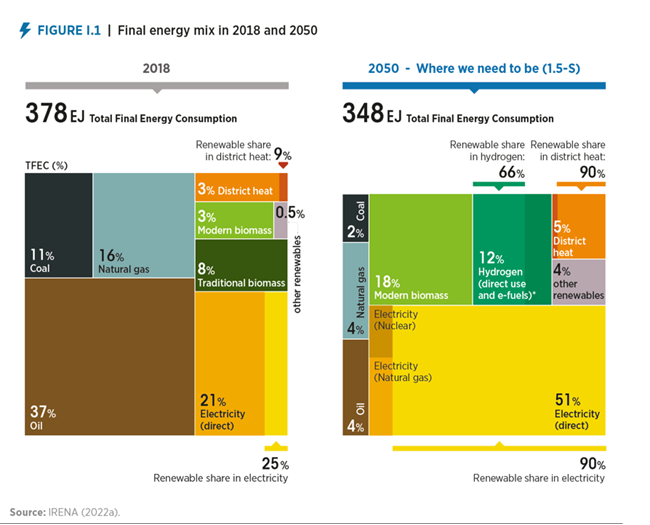How to decarbonise end-use sectors with renewable power?
Electrification is key to achieving global goals
According to IRENA’s 1.5°C Scenario, the share of electricity in total final energy consumption must increase from 21% in 2019 to 51% by 2050. This can be achieved by ramping up electric-powered technologies – many of which are available today.
Governments around the world should see electrification as a major opportunity to decarbonise end-use sectors, improve energy security and reliability and reduce exposure to the price volatility of imported fuels.

Mass electrification requires a smart approach
Smart electrification is a cost-effective decarbonisation pathway for energy systems. It involves the electrification of end-use sectors by incorporating large shares of renewables.
By reducing peak loads, smart electrification strategies minimise the impacts of additional electricity demand in power systems. They can also provide added flexibility,
Innovation is the engine powering the global energy transformation towards a carbon-neutral future. It also the driving force for smart electrification of end-use sectors.
Systemic innovation can accelerate the energy transition
Innovative solutions go beyond the boundaries of technology and must include also market design, system planning and operation, and business models.
Successful solutions must leverage synergies across innovations in all parts of the system and include all relevant actors and stakeholders.
This is called systemic innovation.
There is no “one-size-fits-all” solution for smart electrification
Smart charging strategies – and the way they are implemented – vary among countries. They depend on the specific attributes of power systems and end-use sectors, as well as social and cultural factors.
IRENA’s 2023 Innovation landscape report offers a toolbox of 100 innovations that can be used to design decarbonisation strategies for transport, heating and cooling, and hydrogen production.
Using the toolbox, governments can build customised smart electrification strategies.
The electrification of mobility poses multiple challenges
IRENA estimates that there will be 1 780 million electric cars on the road by 2050, compared to only 18 million in 2019.
This will place unprecedented demands on the electricity system; IRENA estimates that transport sector electrification will reach 10% by 2030 and almost 50% by 2050.
The widespread adoption of electric vehicles (EVs) will therefore require power grids that can meet this demand using renewable-based electricity.
Smart electrification strategies can allow the integration of more variable renewable energy, whilst reducing peak loads and grid investment needs.
Choosing the best smart charging strategy
The design of an effective smart electrification strategy depends on many variables, such as power system flexibility, grid capacity, and mobility needs. A bespoke smart strategy can be designed using a toolbox of 35 innovations for electrifying mobility.
The innovation toolbox can be used to build smart electrification strategies for different transportation segments, such as passenger cars; two- and three-wheelers; light commercial vehicles, heavy-duty vehicles; and buses.
Smart solutions are needed for heating and cooling
Heating and cooling account for about half of global final energy consumption. Together, they represent the largest energy end use, and produce more than 40% of global energy-related CO2 emissions.
Smart electrification strategies make it possible to integrate more renewable power, reduce peak loads and congestion, add power system flexibility, and avoid investments in additional generation, transmission and distribution. In short, they sharply reduce dependence on fossil fuels whilst also reducing costs and environmental impacts.
Creating a smart electrification strategy for heating and cooling
Smart electrification strategies are heavily context dependent; there is no ‘one-size-fits-all’ solution.
They aim to create heating and cooling systems that are clean, efficient and smartly coupled with power systems.
Systemic innovation is needed to break down silos between stakeholders - including utility companies, power grid operators, district heating and cooling companies, and building and industrial energy managers. Using the toolbox, smart electrification strategies can be designed for district heating and cooling, buildings and industry.
Green hydrogen will be vital in hard-to-decarbonise sectors
Direct electrification is difficult, if not impossible, in some end-use sectors like steelmaking, chemical production, long-haul aviation and maritime shipping. However, green hydrogen and its derivatives can provide viable solutions for their decarbonisation. Hydrogen can also serve as an excellent energy storage medium.
Under IRENA’s 1.5°C Scenario, the production of green hydrogen and its derivatives would increase from negligible levels today to 31 million tonnes by 2050.
Smart production of green hydrogen can accelerate decarbonisation
To realise the full potential of green hydrogen, significant innovation will be needed in multiple areas to
- rapidly scale up electrolyser manufacturing;
- build the infrastructure needed to produce, store and transport hydrogen and its derivates; and
- establish new business models, market designs and regulations for a growing hydrogen market.
A toolbox of 30 innovations can be used to design a smart strategy for green hydrogen production that reflects the energy system’s specific attributes, as well as how the hydrogen will be produced and used.
Explore more on this topic
Browse these Related publications:
